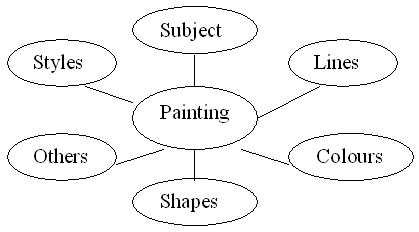Objectives. 1. Educational objectives.
- To revise the vocabulary associated with painting.
- To practise listening, note-taking, speaking and discussion.
- To practise describing paintings using a plan and giving
opinions about them.
2. Developmental objectives.
- To increase awareness of main art styles of the 20th
century.
- To increase awareness of beauty of the modern painting.
3. Educative objectives.
- To make students understand the importance of studying arts as a
world culture to be
tolerant to different nations and cultures.
I. Brainstorming activity. (Discussing a quotation)
Let’s pay our attention to the words of the Irish writer O.
Wilde "All art
is useless”
- What do you think of this idea?
- Do you agree with it?
II. Warming up activity. (Revising the vocabulary)Distribute these words and phrases under the correct heading. (Pair
Work) Realistic, in the foreground, landscape, light, round, in the
background, straight,
abstract, at the top/ bottom, portrait, dark, geometric, on the
left/right, wavy, pop,
war, bright, square, clear, cubist, soft, impressionism, scenes from
everyday life,
strong, street scenes. 
III. Listening.1. Pre listening activity. Look at the screen. There are works of art by some modern painters of
the 20th
century.
- Do you know these names?
- What do you know about them?
2. Listening Task. Listen to four people talking about these pictures and identify the
paintings. Take
notes. Tapescript 1 Well, I really like this picture – it's easy to see what's
happening. I like
the bright colours – of the girl's blue dress and her blonde hair. I
also like the round
shapes in the picture. I think the topic is interesting too – the girl
looks worried and
she's thinking about her boyfriend ' 2 Personally, I think this one is good. It's got very
strong lines and you can
almost feel the music. And the colours they're great – they're really
bright. I like
abstract paintings because you have to use your own imagination to
understand what the
painter is trying to do. I think ... 3 This one's my favourite. It shows the horrors of war
really well – with the
dark, dark colours and the terrible images. The lines and shapes are
square and
geometrical. They show violence and pain. Look at the horse and the
mother with her dead
child. It's a very frightening painting because ... 4 Well, I think this one's the best. I really like the
bright colours and the clear
lines. I love the colour of the water in the swimming pool. The style's
strange – it's
realistic but very simple at the same time ... Answers:
- I know… Brad by Roy Lichtenstein
- Improvisation 28 by Vassiliy Kandinsky
- Guernicaby Pablo Picasso
- A Bigger Splash by David Hockny
3. After listening activity. Talk about the paintings. Which of them do you like most? Express you
opinion. IV. Studying the topic. (Styles definitions)Match the art styles with definitions. (Pair Work)
- Impressionism
- Cubism
- Abstract painting
- Realistic style
- Pop art
- It’s the art that doesn’t represent recognizable objects.
- It promotes accurate, detailed depiction of nature or
contemporary life. It rejects
imaginative idealization in favour of close observation.
- It’s the conception of art as imitation of nature. Its subject
included landscapes,
tress, houses, street scenes. The artists paid attention to
effects of light and movement.
- The key concept of this style is that essence of the object can
only be shown from
different points of view at once. Its works reject perspective in
favour of geometric
forms.
- The art in which common objects (such as comic strips, soup
cans, road signs, and
hamburgers) were used as subject matter.
Answers:
- Impressionism – c
- Cubism – d
- Abstract – a
- Realistic – b
- Pop art – e
What are the differences among the art styles? V. Reports about impressionism, Edouard Manet and Pablo Picasso.Today we’ll get acquainted with two main representatives of painting. Until the second half of the 19th century, the most important style
was Classicism.
The usual was that artists displayed their pictures in the official
hall. The main palette
was in dark colours – brown, black. The main subject was a human,
sometimes idealised. In the late 19th century a new movement called impressionism
developed
in France. The painters rejected the traditional brown, grey, and green
colours in favour
of a lighter, more brilliant palette. They often painted out of doors,
rather than in the
studio. Their subject matter included landscapes, trees, houses, and
even street scenes
and railroad stations. Edouard Manet (1832-1883), a French painter, is regarded
as the most important
master of Impressionism. Edouard Manet travelled to Spain and was
touched by its way of
life, traditions, folklore and the world of bullfighters and young
girls. There, he could
learn from works of great painters such as Velazquez and Goya, who absolutely influenced his work. But he was a painter of modern life, who showed life as it was,
without idealisation.
It caused a big scandal. The refined public of the moment was not ready
to accept a
revolution like that. Pablo Picasso (1881 – 1973) was a Spanish painter and one
of the recognized
figures in the 20th century art, probably most famous as the founder of the cubism. The movement itself was not long-lived or widespread, but it began an
creative
explosion in the art of the 20th century.
In 1907 after numerous studies and variations Picasso painted his first
cubistic picture – "Les demoiselles d’Avignon”. Impressed with African sculptures at ethnographic
museum he tried
to combine the angular structures of the "primitive art” and his new
ideas about
cubism." What have you learnt about the artists and their works? What are the main features of impressionist works? (Light colours,
brilliant
palette, out of doors, not in a studio) VI. Describing the paintings. (Group Work)There are three paintings of different artists on the same topic, the
same name: "The
Luncheon on the Grass” by Edouard Manet, by Claude Monet, by
Pablo Picasso. Describe one of the paintings using the plan.
- What kind of painting is it?
- What is the subject?
- What is happening in the picture?
- What colours/ lines/ shapes are used?
- What is your opinion of it?
1) "The Luncheon on the Grass” by… is a good example of
… style. It was painted in the late 19th / in the middle of the
20th
century. 2) The main subject of the painting is ... .
- It shows people in the park having a picnic…
- The artist brilliantly used … in the picture.
- I think… / In my opinion…/ To my mind…
VII. Summing up.– Which of the paintings do you like most? Why? – How did the artists express the same things? All people are different. Even the same things they see in different ways. But the attempt to understand the art in its variety is an attempt to
understand the
national culture and the world culture in general. Understanding of world culture makes people be temperate and tolerant
to each other,
helping people live in peace (culture of peace) VII. Home task: Describe your favourite painting. Student’s Handout Ex. 1 Distribute these words and phrases under the correct heading. Realistic, in the foreground, landscape, light, round, in the
background, straight,
abstract, at the top/ bottom, portrait, dark, geometric, on the
left/right, wavy, pop,
war, bright, square, clear, cubist, soft, impressionism, scenes from
everyday life,
strong, street scenes. 
Ex.2 Match the art styles with definitions.
- Impressionism
- Cubism
- Abstract painting
- Realistic style
- Pop art
- It’s the art that doesn’t represent recognizable objects.
- It promotes accurate, detailed depiction of nature or
contemporary life. It rejects
imaginative idealization in favour of close observation.
- It’s the conception of art as imitation of nature. Its subject
included landscapes,
tress, houses, street scenes. The artists paid attention to
effects of light and movement.
- The key concept of this style is that essence of the object can
only be shown from
different points of view at once. Its works reject perspective in
favour of geometric
forms.
- The art in which common objects (such as comic strips, soup
cans, road signs,
and hamburgers) were used as subject matter. Ex. 3 Describe the paintings using the plan.
- What kind of painting is it?
- What is the subject?
- What is happening in the picture?
- What colours/ lines/ shapes are used?
- What is your opinion of it?
1) "The Luncheon on the Grass” by… is a good example of
… style. It was painted in the late 19th / in the middle of the
20th
century. 2) The main subject of the painting is ... .
- It shows people in the park having a picnic…
- The artist brilliantly used … in the picture.
- I think… / In my opinion…/ To my mind…
Презентация
| 
